Comparative Assessment of Digital and Conventional Soil Mapping: A Case Study of the Southern Cis-Ural Region, Russia
Abstract
:1. Introduction
2. Objects and Methods
2.1. Study Site Description
2.2. CSM and Field Data Processing
2.3. DSM Methodology
3. Results and Discussion
4. Conclusions
Author Contributions
Funding
Data Availability Statement
Conflicts of Interest
References
- Nikiforova, A.A.; Fleis, M.E.; Nyrtsov, M.V.; Kazantsev, N.N.; Kim, K.V.; Belyonova, N.K.; Kim, J.K. Problems of modern soil mapping and ways to solve them. Catena 2020, 195, 104885. [Google Scholar] [CrossRef]
- Hartemink, A.E.; Krasilnikov, P.; Bockheim, J.G. Soil maps of the world. Geoderma 2013, 207–208, 256–267. [Google Scholar] [CrossRef]
- Kozlov, D.N.; Sorokina, N.P. Tradition and innovation in large-scale soil mapping. In Digital Soil Mapping: Theoretical and Experimental Research; V.V. Dokuchaev Soil Science Institute: Moscow, Russia, 2012; pp. 35–57. (In Russian) [Google Scholar]
- Baruck, J.; Nestroy, O.; Sartori, G.; Baize, D.; Traidl, R.; Vrščaj, B.; Bräm, E.; Gruber, F.E.; Heinrich, K.; Geitner, C. Soil classification and mapping in the Alps: The current state and future challenges. Geoderma 2016, 264, 312–331. [Google Scholar] [CrossRef]
- Hartemink, A.E.; Hempel, J.; Lagacherie, P.; McBratney, A.B.; McKenzie, N.J. GlobalSoilMap.net—A New Digital Soil Map of the World. In Digital Soil Mapping. Bridging Research, Environmental Application, and Operation; Boettinger, J.L., Howell, D.W., Moore, A.C., Hartemink, A.E., Kienast-Brown, S., Eds.; Springer: Dordrecht, The Netherlands, 2010; pp. 423–428. [Google Scholar]
- McBratney, A.B.; Mendonça Santos, M.L.; Minasny, B. On Digital Soil Mapping. Geoderma 2003, 117, 3–52. [Google Scholar] [CrossRef]
- Omuto, C.; Nachtergaele, F.; Rojas, R.V. State of the Art Report on Global and Regional Soil Information: Where Are We? Where To Go? Food and Agriculture Organization of the United Nations: Rome, Italy, 2013; ISSN 9251074496. [Google Scholar]
- Sanchez, P.A.; Ahamed, S.; Carré, F.; Hartemink, A.E.; Hempel, J.; Huising, J.; Lagacherie, P.; McBratney, A.B.; McKenzie, N.J.; Mendonça-Santos, M.L.; et al. Digital Soil Map of the World. Science 2009, 325, 680–681. [Google Scholar] [CrossRef] [PubMed] [Green Version]
- Brevik, E.C.; Calzolari, C.; Miller, B.A.; Pereira, P.; Kabala, C.; Baumgarten, A.; Jordán, A. Soil mapping, classification, and pedologic modeling: History and future directions. Geoderma 2016, 264, 256–274. [Google Scholar] [CrossRef]
- Regmi, N.R.; Rasmussen, C. Predictive mapping of soil-landscape relationships in the arid Southwest United States. Catena 2018, 165, 473–486. [Google Scholar] [CrossRef]
- Arrouays, D.; Poggio, L.; Salazar Guerrero, O.A.; Mulder, V.L. Digital soil mapping and GlobalSoilMap. Main advances and ways forward. Geoderma Reg. 2020, 21, e00265. [Google Scholar] [CrossRef]
- Shershukova, G.A. Development stages of the large-scale mapping of soils in the USSR. In Large-Scale Soil Mapping; Grigoriev, G.I., Ed.; Science: Moscow, Russia, 1971; pp. 144–166. (In Russian) [Google Scholar]
- Fridland, V.M. Pattern of the Soil Cover; John Wiley & Sons: Hoboken, NJ, USA, 1977; ISBN 978-0470991671. [Google Scholar]
- Khitrov, N.; Smirnova, M.; Lozbenev, N.; Levchenko, E.; Gribov, V.; Kozlov, D.; Rukhovich, D.; Kalinina, N.; Koroleva, P. The soil cover patterns of forest-steppe and steppe zones at the East-European Plain. Soil Sci. Annu. 2019, 70, 198–210. [Google Scholar] [CrossRef]
- Koshelev, A.V. Digital mapping of soils with the use of SRTM data. In Bulletin of the Lower Volga Agro-University Complex: Science and Higher Professional Education; Volgograd State Agrarian University: Volgograd, Russia, 2018; Volume 52, pp. 159–166, (In Russian). [Google Scholar] [CrossRef]
- Savin, I.Y.; Ovechkin, S.V. On the updating of medium-scale soil maps. Eurasian Soil Sci. 2014, 47, 987–994. [Google Scholar] [CrossRef]
- Zhidkin, A.P.; Smirnova, M.A.; Gennadiev, A.N.; Lukin, S.V.; Zazdravnykh, Y.A.; Lozbenev, N.I. Digital Mapping of Soil Associations and Eroded Soils (Prokhorovskii District, Belgorod Oblast). Eurasian Soil Sci. 2021, 54, 13–24. [Google Scholar] [CrossRef]
- Arrouays, D.; Richer-De-Forges, A.C.; Héliès, F.; Mulder, V.L.; Saby, N.P.; Chen, S.; Martin, M.P.; Dobarco, M.R.; Follain, S.; Jolivet, C.; et al. Impacts of national scale digital soil mapping programs in France. Geoderma Reg. 2020, 23, e00337. [Google Scholar] [CrossRef]
- Minasny, B.; McBratney, A.B. Digital soil mapping: A brief history and some lessons. Geoderma 2016, 264, 301–311. [Google Scholar] [CrossRef]
- Gabbasova, I.M.; Khabirov, I.K. Distribution, typology and assessing degraded soils of Bashkortostan. Vestn. Bashkir State Agrar. Univ. 2010, 2, 3–11. (In Russian) [Google Scholar]
- Peel, M.C.; Finlayson, B.L.; McMahon, T.A. Updated world map of the Köppen-Geiger climate classification. Hydrol. Earth Syst. Sci. 2007, 11, 1633–1644. [Google Scholar] [CrossRef] [Green Version]
- Selyaninov, G.L. About the agricultural evaluation of the climate. Trudy GGO 1928, 20, 177–185. (In Russian) [Google Scholar]
- Abdrakhmanov, R.F.; Batanov, B.N.; Gabbasova, I.M.; Komissarov, A.V.; Maslov, V.V.; Yunusov, S.A. Water Balance Station; BSAU: Ufa, Russia, 2002; p. 82. (In Russian) [Google Scholar]
- Sobol, N.V.; Gabbasova, I.M.; Komissarov, M.A. Effect of rainfall intensity and slope steepness on the development of soil erosion in the Southern Cis-Ural region (A model experiment). Eurasian Soil Sci. 2017, 50, 1098–1104. [Google Scholar] [CrossRef]
- Khalevitskaya, G.S.; Babkina, M.I.; Kuznetsova, V.V. Agroclimatic Resources of the Bashkir ASSR; Gidrometeoizdat: Leningrad, Russia, 1976; p. 235. (In Russian) [Google Scholar]
- Komissarov, M.A.; Gabbasova, I.M. Snowmelt-induced soil erosion on gentle slopes in the southern Cis-Ural region. Eurasian Soil Sci. 2014, 47, 598–607. [Google Scholar] [CrossRef]
- Sobol, N.V.; Gabbasova, I.M.; Komissarov, M.A. Impact of climate changes on erosion processes in Republic of Bashkortostan. Arid Ecosyst. 2015, 5, 216–221. [Google Scholar] [CrossRef]
- Smirnov, A.I.; Durnaeva, V.N.; Abdrakhmanov, R.F. GIS-technologies in study of geohazards of the southern Urals and Cis-Urals. Geol. Bull. 2018, 137–143. [Google Scholar] [CrossRef]
- Khasanov, A.N. The Current State of Soil Fertility in Agricultural Landscapes of the Southern Forest-Steppe of the Republic of Bashkortostan. Ph.D. Thesis, Bashkir State Agrarian University, Ufa, Russia, 4 October 2019. (In Russian). [Google Scholar]
- Bugaets, A.N.; Pshenichnikova, N.F.; Tereshkina, A.A.; Krasnopeev, S.M.; Gartsman, B.I. Analysis of the spatial differentiation of the soil cover in the south of the Far East of Russia by the example of the Komarovka River basin. Eurasian Soil Sci. 2015, 48, 231–239. [Google Scholar] [CrossRef]
- Khaziev, F.K. Soils of Bashkortostan. Vol. 1. Ecologic-Genetic and Agroproductive Characterization; Gilem: Ufa, Russia, 1995; p. 385. (In Russian) [Google Scholar]
- Conrad, O.; Bechtel, B.; Bock, M.; Dietrich, H.; Fischer, E.; Gerlitz, L.; Wehberg, J.; Wichmann, V.; Böhner, J. System for automated geoscientific analyses (SAGA) v. 2.1.4. Geosci. Model Dev. 2015, 8, 1991–2007. [Google Scholar] [CrossRef] [Green Version]
- Florinsky, I.V. Digital Terrain Analysis in Soil Science and Geology; Academic Press: Amsterdam, The Netherlands, 2016; p. 506. [Google Scholar]
- Hole, F.D.; Campbell, J.B. Soil Landscape Analysis; Rowman and Littlefield: Lanham, MD, USA, 1985; p. 214. ISBN 978-0865981409. [Google Scholar]
- Puzachenko, Y.G. Mathematical Methods in Environmental and Geographic Research; Academy: Moscow, Russia, 2004; p. 416. (In Russian) [Google Scholar]
- Webster, R.; Burrough, P.A. Multiple discriminant analysis in soil survey. Eur. J. Soil Sci. 1974, 25, 120–134. [Google Scholar] [CrossRef]
- Panagos, P.; Borrelli, P.; Meusburger, K.; Yu, B.; Klik, A.; Lim, K.J.; Yang, J.E.; Ni, J.; Miao, C.; Chattopadhyay, N. Global rainfall erosivity assessment based on high-temporal resolution rainfall records. Sci. Rep. 2017, 7, 4175. [Google Scholar] [CrossRef] [PubMed] [Green Version]
- Larionov, G.A. Soil Erosion and Deflation: Basic Patterns and Quantitative Estimates; Moscow University Publishing House: Moscow, Russia, 1993; p. 200. (In Russian) [Google Scholar]
- Kozlov, D.N.; Zhidkin, A.P.; Lozbenev, N.I. Digital Mapping of Soil Cover Eroded Patterns on the Basis of Soil Erosion Simulation Model (Northern Forest-Steppe of the Central Russian Upland); V.V. Dokuchaev Soil Science Institute: Moscow, Russia, 2019; Volume 100, pp. 5–35, (In Russian). [Google Scholar] [CrossRef]
- IUSS Working Group WRB. World Reference Base for Soil Resources 2014, update 2015. International soil classification system for naming soils and creating legends for soil maps. In World Soil Resources Reports; FAO: Rome, Italy, 2015; p. 182. [Google Scholar]
- Weiss, A. Topographic position and landforms analysis. In Proceedings of the Poster Presentation, ESRI User Conference, San Diego, CA, USA, 9–13 July 2001; Volume 200. [Google Scholar]
- Olaya, V.; Conrad, O. Geomorphometry in SAGA. Dev. Soil Sci. 2009, 33, 293–308. [Google Scholar] [CrossRef]
- Zhidkin, A.P.; Komissarov, M.A. Erosion and accumulation microstructures of soil cover in the forest-steppe zone of the Cis-Urals, the Republic of Bashkortostan. Vestn. Bashkir State Agrar. Univ. 2020, 53, 12–20. (In Russian) [Google Scholar] [CrossRef]
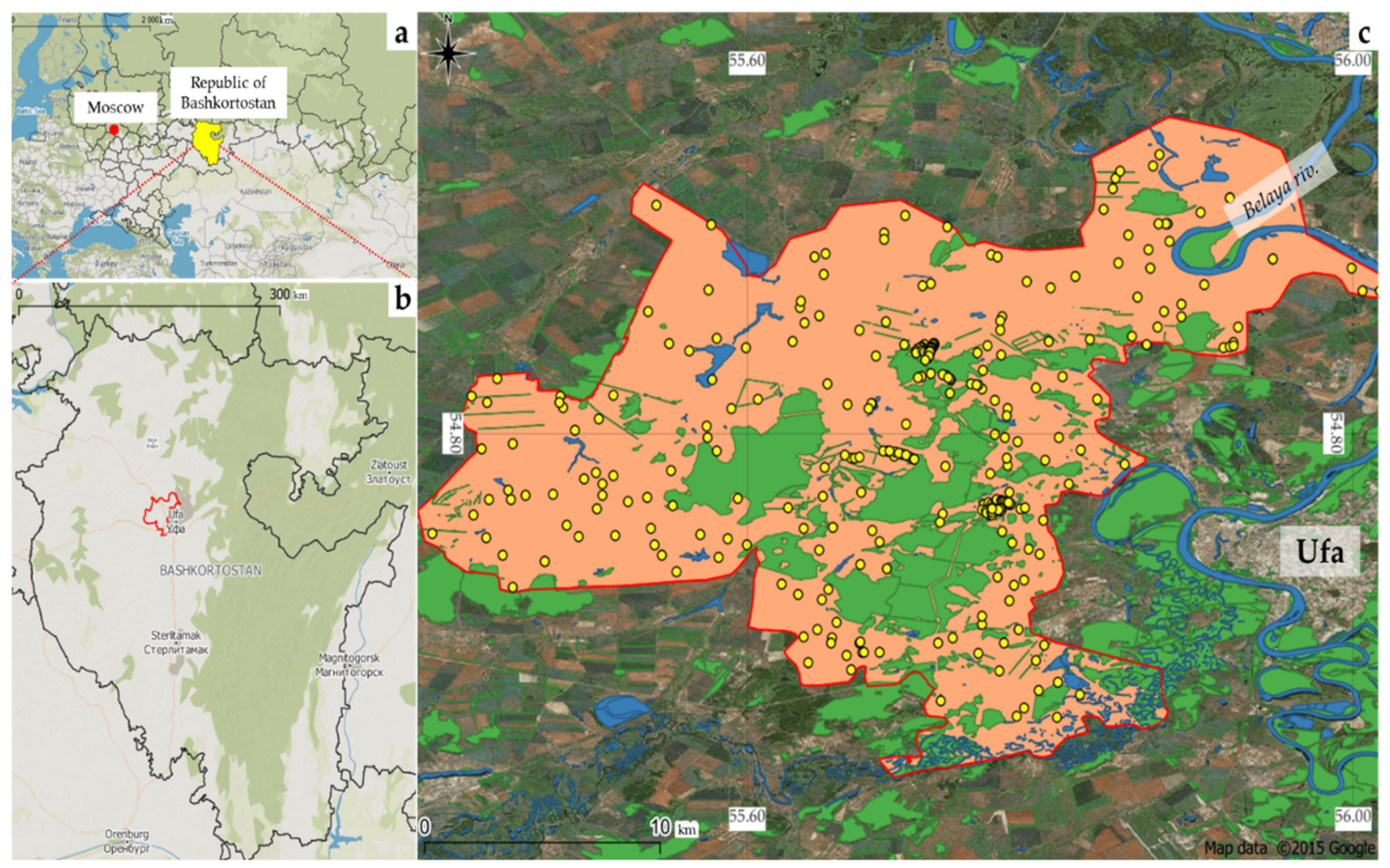
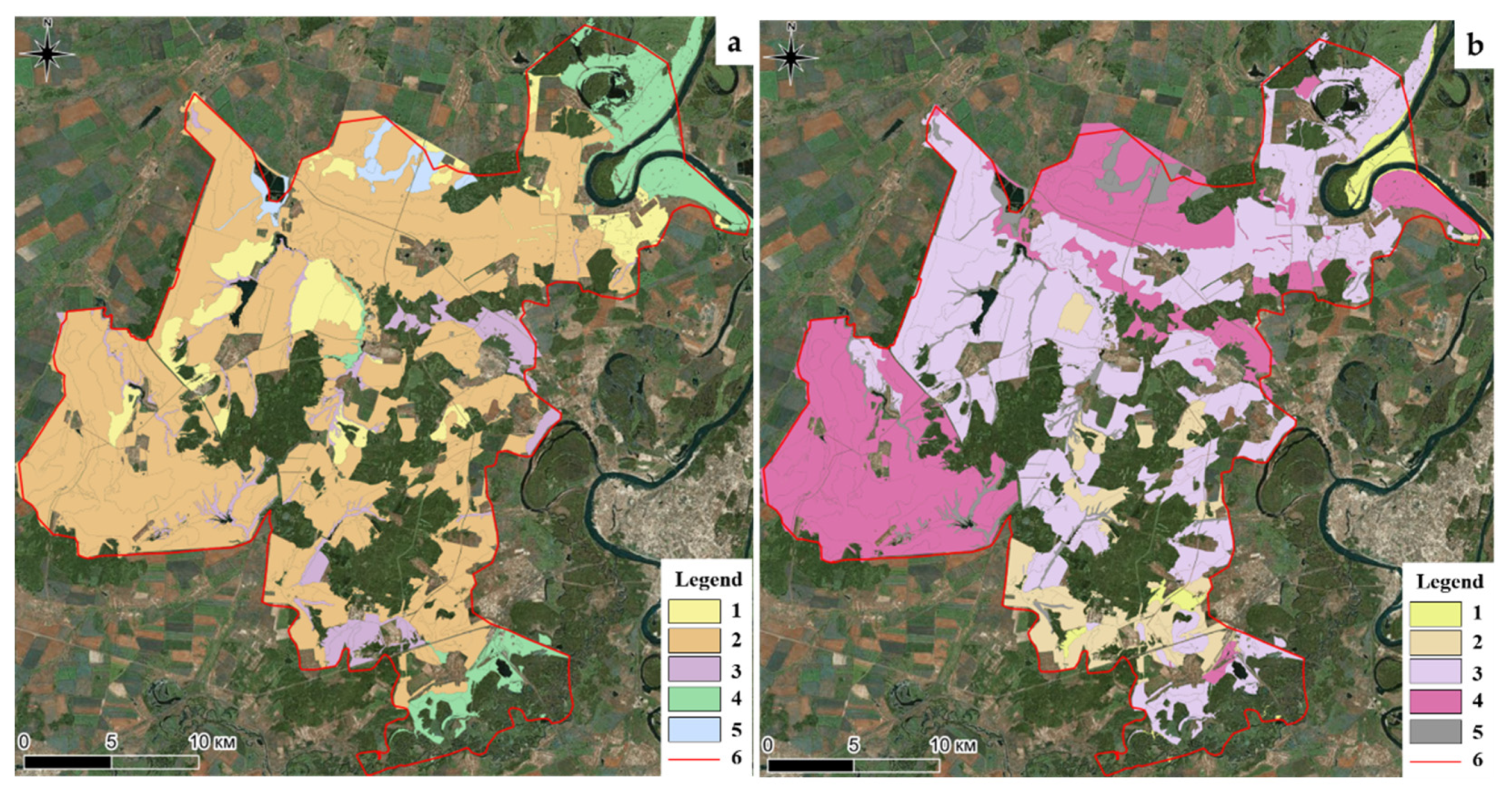
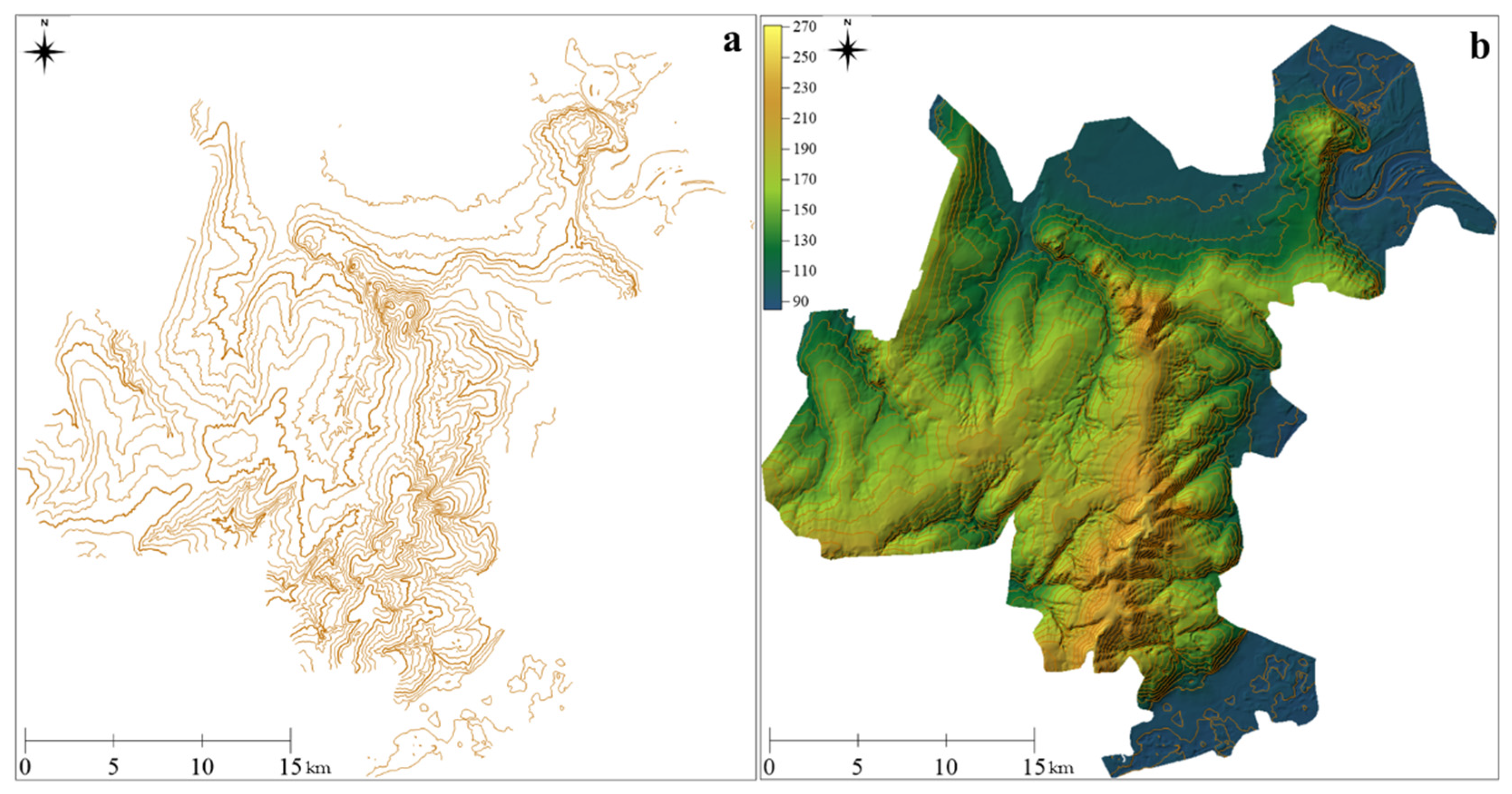
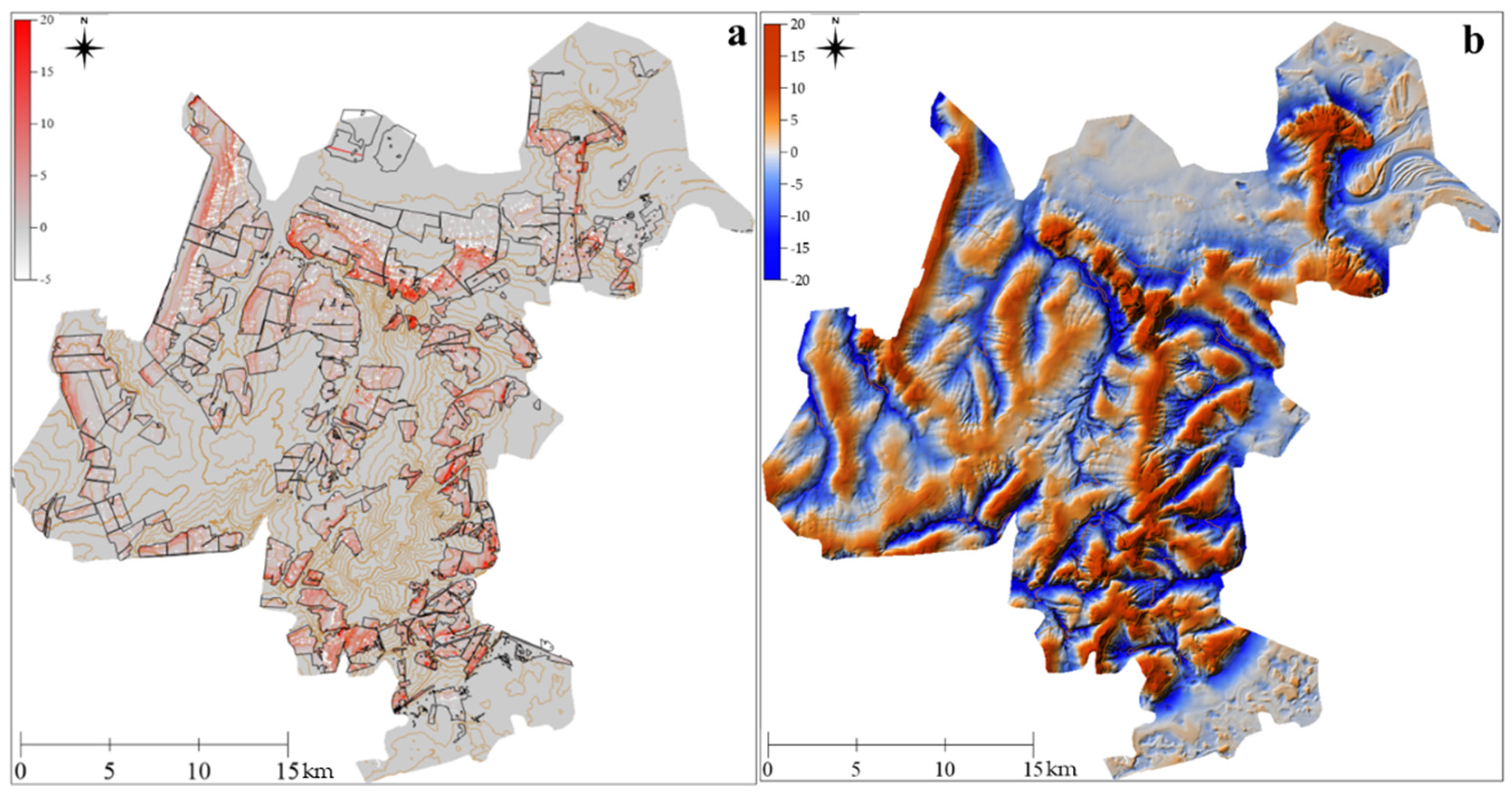
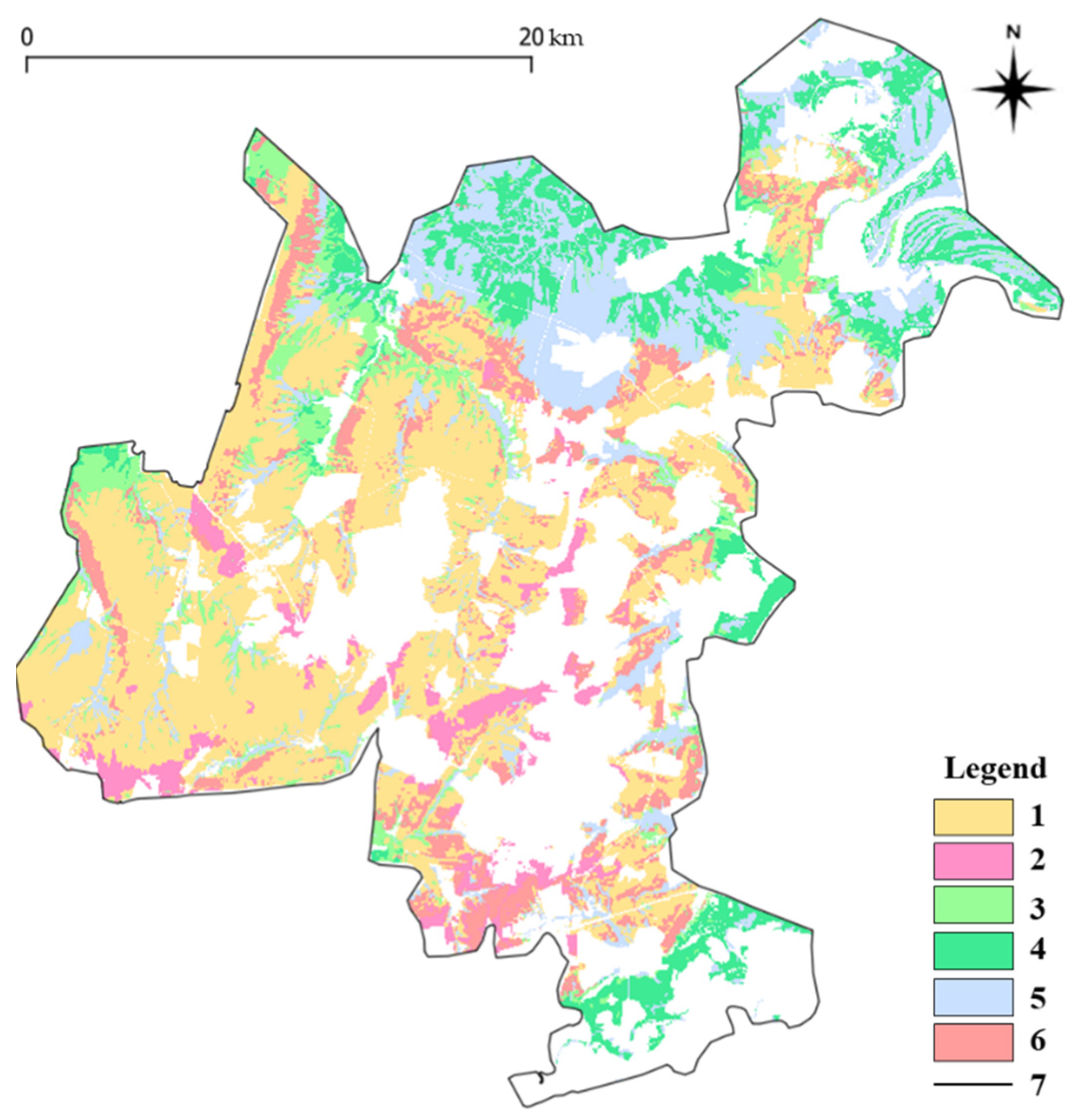

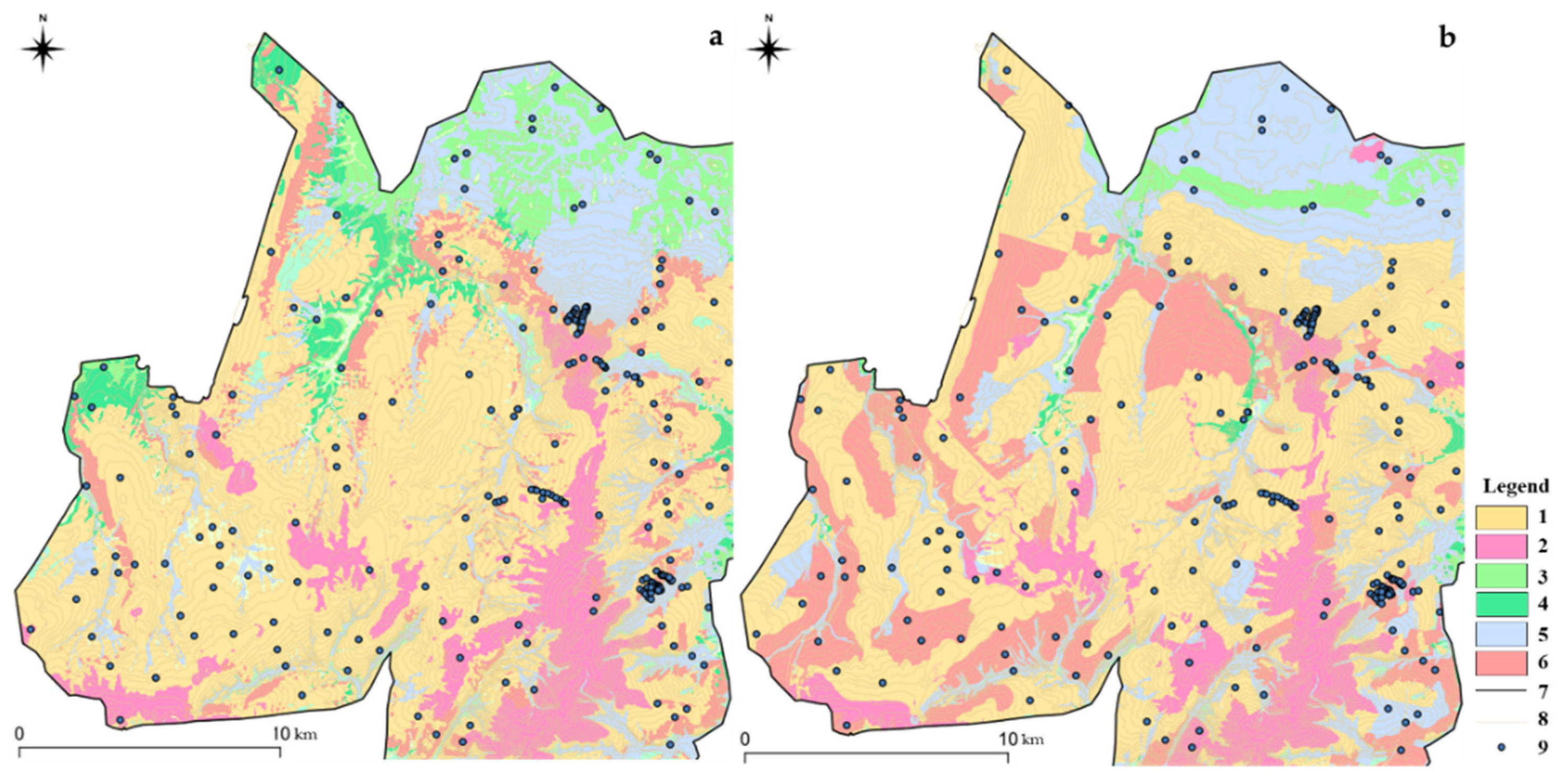
| Terrain Parameter | Fisher’s Criterion | p-Value | Physical Sense |
|---|---|---|---|
| Intercept | 29.1 | 0.0 | |
| Topographic wetness index | 17.0 | 0.0 | Separates soils of an increasing range of moisture as moisture accumulates in concave relief elements |
| Channel network base level | 15.6 | 0.0 | Determines the position of sandy stagnic soils within the high interfluves |
| Relative slope position | 20.1 | 0.0 | |
| Topographic position index | 16.0 | 0.0 | Separates soils of convex and concave landforms |
| No. and Color of Soil Group | WRB Index | Accuracy, % | Predicted Soils, Units | ||||
|---|---|---|---|---|---|---|---|
| Ch | Ar | St Ph | Fl | Gl Ph | |||
| 1 | Ch | 69 | 138 | 24 | 1 | 8 | 11 |
| 2 | Ar | 50 | 17 | 22 | 1 | 1 | 3 |
| 3 | St Ph | 35 | 2 | 1 | 6 | 7 | 1 |
| 4 | Fl | 72 | 0 | 0 | 4 | 15 | 2 |
| 5 | Gl Ph | 42 | 2 | 1 | 0 | 4 | 5 |
| General | 57 | 200 | 53 | 12 | 35 | 24 | |
| No. and Color of Soil Group | WRB Index | DSM | CSM | Area Difference, ha | ||
|---|---|---|---|---|---|---|
| Area, ha | % | Area, ha | % | |||
| 1 | Ch | 22,286 | 43 | 20,732 | 40 | 1554 |
| 2 | Ar | 2690 | 5 | 3628 | 7 | 938 |
| 3 | St Ph | 2802 | 5 | 5701 | 11 | 2899 |
| 4 | Fl | 8246 | 16 | 2073 | 4 | 6173 |
| 5 | Gl Ph | 9896 | 19 | 6220 | 12 | 3676 |
| 6 | Er | 5910 | 11 | 13,476 | 26 | 7566 |
| Total | 51,830 | |||||
Publisher’s Note: MDPI stays neutral with regard to jurisdictional claims in published maps and institutional affiliations. |
© 2022 by the authors. Licensee MDPI, Basel, Switzerland. This article is an open access article distributed under the terms and conditions of the Creative Commons Attribution (CC BY) license (https://creativecommons.org/licenses/by/4.0/).
Share and Cite
Lozbenev, N.; Komissarov, M.; Zhidkin, A.; Gusarov, A.; Fomicheva, D. Comparative Assessment of Digital and Conventional Soil Mapping: A Case Study of the Southern Cis-Ural Region, Russia. Soil Syst. 2022, 6, 14. https://doi.org/10.3390/soilsystems6010014
Lozbenev N, Komissarov M, Zhidkin A, Gusarov A, Fomicheva D. Comparative Assessment of Digital and Conventional Soil Mapping: A Case Study of the Southern Cis-Ural Region, Russia. Soil Systems. 2022; 6(1):14. https://doi.org/10.3390/soilsystems6010014
Chicago/Turabian StyleLozbenev, Nikolai, Mikhail Komissarov, Andrey Zhidkin, Artyom Gusarov, and Daria Fomicheva. 2022. "Comparative Assessment of Digital and Conventional Soil Mapping: A Case Study of the Southern Cis-Ural Region, Russia" Soil Systems 6, no. 1: 14. https://doi.org/10.3390/soilsystems6010014
APA StyleLozbenev, N., Komissarov, M., Zhidkin, A., Gusarov, A., & Fomicheva, D. (2022). Comparative Assessment of Digital and Conventional Soil Mapping: A Case Study of the Southern Cis-Ural Region, Russia. Soil Systems, 6(1), 14. https://doi.org/10.3390/soilsystems6010014









